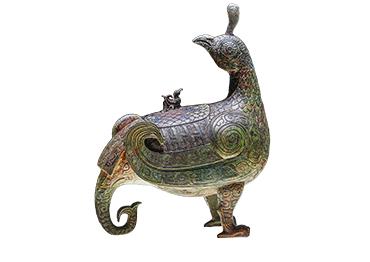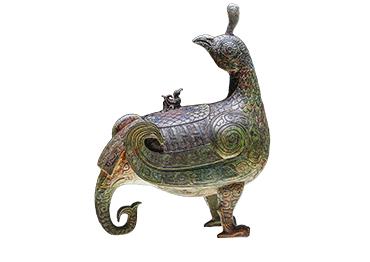The story of the Jinhou Bird Zun is tied to the founding of the Jin State. More than 3,000 years ago, after defeating the Shang Dynasty (1600-1046 BCE), King Wu founded the Western Zhou. Upon King Wu’s death, his young son, King Cheng, ascended the throne in 1042 BCE. Still a child, King Cheng was placed under the regency of his uncle, the Duke of Zhou, who had assisted King Wu in establishing the dynasty.
Suspicious that the Duke of Zhou intended to usurp the throne, other members of the royal family colluded with former Shang supporters and eastern tribes in a rebellion. The Duke of Zhou led a three-year campaign to eventually quash the uprising, taking a series of small vassal states, including the Tang State.
One of the most famous stories from this period is how King Cheng conferred a title of nobility to his younger brother, Shuyu. The two were playing together when the king learned of his uncle’s victory. Overjoyed, he cut a fallen leaf into the shape of a jade tablet, a ritual object at the time. Using it to symbolize the deed to the Tang State, King Cheng gave it to his brother Shuyu.
This act was recorded by one of King Cheng’s ministers, writing “the king’s words are to be taken seriously.” This story gave rise to the idiom jun wu xi yan, literally meaning “a king doesn’t kid around.”
Later in his reign over the Tang State, Shuyu developed irrigation systems that significantly boosted agricultural productivity. One year, he presented a robust wheat crop to King Cheng that had grown two ears per stalk, believing it an auspicious symbol of peace and unity in the world. The king praised Shuyu for his harvest and the thriving Tang State.
Shuyu’s son, Xiefu, succeeded him and renamed the state from Tang to Jin. The earliest known instance of the character jin, discovered on the bird zun, is thought to resemble the two-eared wheat stalk that brought honor to his father.
Xiefu also founded the Jinci, the ancestral temple of the Jin, a state that remained a dominant power in the Western Zhou for the next 150 years. The Jinci, which was expanded in subsequent dynasties, remains one of Shanxi’s must-see attractions.
The tomb of Xiefu, located at the Tianma-Qucun Site, was one of the most recent excavations. Unfortunately, the tomb had been looted, and a botched blast set off by robbers shattered the bronze artifacts. Among them was the Jinhou Bird Zun, which was broken into more than 100 pieces. A dedicated restoration team spent nearly two years reconstructing the artifact, cleaning the fragments and piecing the vessel back together.
However, a significant portion of the zun’s tail was missing, leading to debate among restorers whether it curved inward or outward. When the zun was first exhibited in 2002, the restorers opted for an inward curve, replacing the missing part with a metal component. Years later, researchers at Peking University solved the puzzle, confirming that the tail’s shape was indeed inward, aligning with the ancient artisans’ original design. In 2019, the tail was reattached, completing the vessel in its full glory.
The phoenix is one of the most revered mythical creatures in Chinese culture, embodying grace, virtue, wisdom and rebirth. Similarly, the restored Jinhou Bird Zun symbolizes the rebirth of the Jin State from the ashes of history. It is housed at Shanxi Museum in Taiyuan, central China’s Shanxi Province where it serves as both a historical treasure and a cultural ambassador for the province.
In addition to being a historical artifact, the Jinhou Bird Zun now also serves as the emblem of Shanxi Museum. In 2023, the province introduced a virtual digital mascot called “Blue Bird.” Inspired by the phoenix-shaped vessel, the mascot aims to promote Shanxi’s history, culture and tourism, creating a modern link to the past.
Visitors to Shanxi Museum can now engage with the Jinhou Bird Zun in playful and interactive ways. They can assemble a wooden building block version of it or enjoy a mango-flavored ice cream shaped like the zun. The choice of mango is a nod to the zun’s original hue, reflecting the brightness and warmth of the bronze artifact.

 Old Version
Old Version
